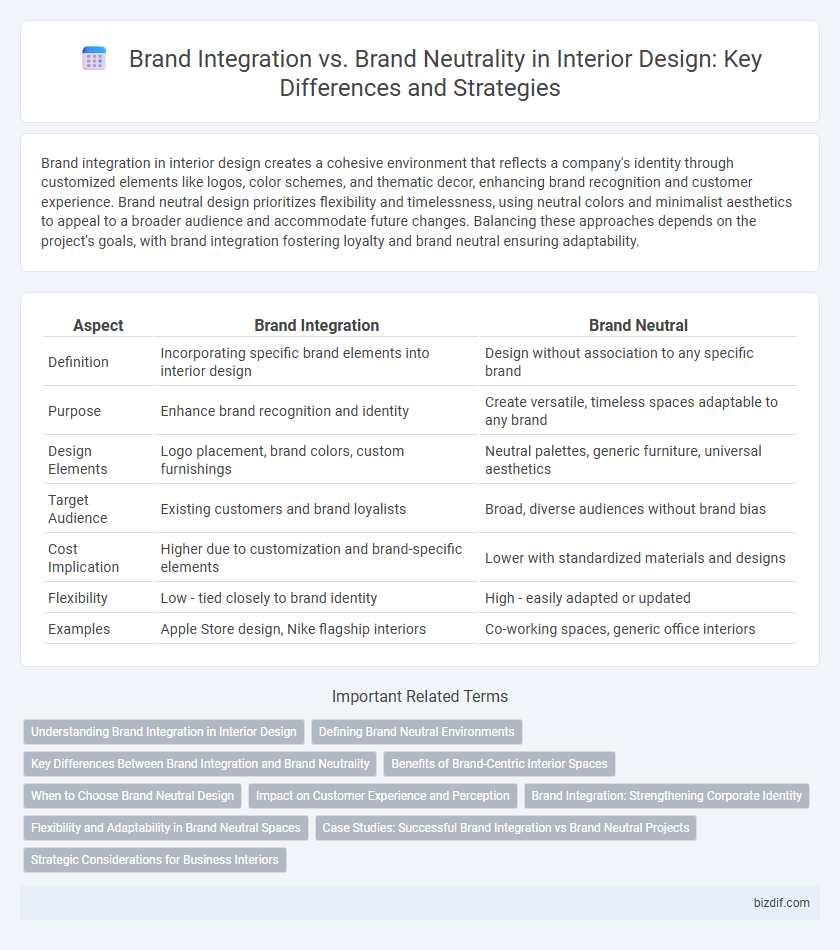Brand integration in interior design creates a cohesive environment that reflects a company's identity through customized elements like logos, color schemes, and thematic decor, enhancing brand recognition and customer experience. Brand neutral design prioritizes flexibility and timelessness, using neutral colors and minimalist aesthetics to appeal to a broader audience and accommodate future changes. Balancing these approaches depends on the project's goals, with brand integration fostering loyalty and brand neutral ensuring adaptability.
Table of Comparison
| Aspect | Brand Integration | Brand Neutral |
|---|---|---|
| Definition | Incorporating specific brand elements into interior design | Design without association to any specific brand |
| Purpose | Enhance brand recognition and identity | Create versatile, timeless spaces adaptable to any brand |
| Design Elements | Logo placement, brand colors, custom furnishings | Neutral palettes, generic furniture, universal aesthetics |
| Target Audience | Existing customers and brand loyalists | Broad, diverse audiences without brand bias |
| Cost Implication | Higher due to customization and brand-specific elements | Lower with standardized materials and designs |
| Flexibility | Low - tied closely to brand identity | High - easily adapted or updated |
| Examples | Apple Store design, Nike flagship interiors | Co-working spaces, generic office interiors |
Understanding Brand Integration in Interior Design
Brand integration in interior design strategically incorporates a company's visual identity, such as logos, color schemes, and messaging, into physical spaces to create immersive brand experiences. This method enhances customer engagement by aligning design elements with brand values and narratives, fostering brand recognition and loyalty. Unlike brand-neutral design, which emphasizes flexibility and neutrality to appeal broadly, brand integration transforms interiors into cohesive storytelling environments that reflect the brand's unique persona.
Defining Brand Neutral Environments
Brand neutral environments prioritize universal appeal by minimizing overt brand elements, creating versatile spaces adaptable for multiple purposes and users. These interiors focus on subtle textures, muted color palettes, and minimalist design principles that do not favor any specific brand identity. Emphasizing functionality and inclusivity, brand neutral designs support diverse user experiences while maintaining a cohesive aesthetic free from explicit branding.
Key Differences Between Brand Integration and Brand Neutrality
Brand integration in interior design involves embedding a company's visual identity and values into the space, creating a cohesive experience that reinforces brand recognition and customer loyalty. Brand neutrality, by contrast, opts for a versatile and unbranded environment that appeals to a broader audience, facilitating flexibility for multiple uses or tenants. Key differences include the level of customization, impact on user perception, and adaptability of the design to changing brand or market needs.
Benefits of Brand-Centric Interior Spaces
Brand-centric interior spaces enhance customer recognition and loyalty by embedding the brand's identity directly into the environment, creating a memorable and cohesive experience. This approach reinforces brand values through tailored design elements, such as color schemes, logos, and thematic decor, which improve emotional connections and brand recall. Unlike brand-neutral spaces, brand integration drives stronger brand differentiation and can increase customer engagement and satisfaction.
When to Choose Brand Neutral Design
Brand neutral design is ideal in shared workspaces, luxury hotels, or multi-tenant retail environments where flexibility and universal appeal are crucial. It allows spaces to adapt easily to various users or clients without conflicting brand identities, promoting inclusivity and broad usability. Choosing brand neutral design supports long-term functionality and avoids frequent costly updates linked to evolving brand guidelines.
Impact on Customer Experience and Perception
Brand integration in interior design creates a cohesive atmosphere by embedding logos, color schemes, and thematic elements, enhancing brand recognition and emotional connection, which can significantly boost customer loyalty. In contrast, brand neutral designs prioritize universal appeal and flexibility, enabling diverse customer preferences but potentially diluting immediate brand identity and recall. Choosing between brand integrated or brand neutral design directly influences how customers perceive authenticity, exclusivity, and overall comfort within a space.
Brand Integration: Strengthening Corporate Identity
Brand integration in interior design strategically incorporates logos, colors, and thematic elements to reinforce corporate identity and create a cohesive brand experience. Thoughtful use of branded signage, custom furnishings, and signature color palettes transforms physical spaces into immersive environments that communicate company values and culture. This approach not only enhances brand recognition but also fosters employee pride and customer loyalty by embedding brand essence into every design detail.
Flexibility and Adaptability in Brand Neutral Spaces
Brand neutral spaces offer unparalleled flexibility, allowing interior designers to adapt layouts and aesthetics easily without the constraints of specific brand elements. This adaptability supports multifunctional use and seamless updates, ensuring spaces remain relevant as needs evolve. Prioritizing neutral palettes and customizable furnishings enhances the potential for diverse branding or user customization over time.
Case Studies: Successful Brand Integration vs Brand Neutral Projects
Case studies in interior design highlight that successful brand integration creates immersive environments that reinforce brand identity and enhance customer engagement, exemplified by Starbucks Reserve Roasteries and Apple Stores. In contrast, brand neutral projects like luxury hotels and coworking spaces prioritize flexible, timeless aesthetics that appeal to broader audiences without overt brand messaging. Analyzing these examples reveals how strategic use of color, materials, and spatial layout drives either a strong brand presence or neutral adaptability in commercial interiors.
Strategic Considerations for Business Interiors
Strategic considerations for business interiors highlight the choice between brand integration and brand-neutral design to reinforce corporate identity or promote flexibility. Brand integration incorporates specific brand colors, logos, and design elements to create a cohesive environment that strengthens employee engagement and client recognition. Brand-neutral interiors prioritize adaptability, allowing spaces to accommodate diverse functions and evolving business needs without strong brand associations.
Brand integration vs brand neutral Infographic

 bizdif.com
bizdif.com